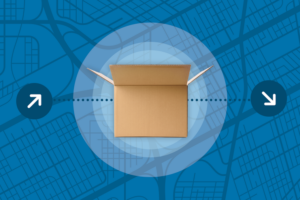Shipping is the process of transporting goods and freight from one place to another through various means: air, water, or land. Goods travel via roads on trucks or by train if they are far away in another part of the continent. Shipping begins when the shipper makes a list of all the items that are to be shipped and why they are being shipped. The shipper organizes their transportation and then follows the journey.
The person who receives a shipped item is called the “consignee.” Their job is to accept the shipment when it arrives. Both consignors and consignees are important parts of ensuring everything goes right during the entire shipment journey.
No shipping arrangement can be successful without knowing the roles and responsibilities of a consignee, especially in the case of LTL shipping. In less-than-truckload (LTL) shipping, there needs to be a few parties to make shipping goods between point A and point B successful: the sender, the mover, and the receiver (a.k.a. consignee). Each party has their own role: The sender must pack, label, and prepare items to be shipped. The mover moves goods on trucks with other stuff. Last but not least, the receiver or consignee receives goods and makes sure they arrive in one piece.
In this article, we define what a consignee is, their function, and potential problems that could arise for this position. Through these points, you can better understand why there are situations where knowing about the role of the consignee matters.
Key Difference Between Consignor And Consignee
A consignee is a person or entity responsible for receiving and accepting the shipment at its final destination. They will check to ensure everything is in order, that the goods have arrived complete and in good condition, and will communicate quickly with the consignor if there are any problems that need to be resolved. Consignees face their own set of challenges. It can take time and strategy to settle issues as they arise, but it must also be done quickly to keep business running smoothly.
The main difference between a consignor and a consignee lies in their primary functions within the supply chain process. When you are acting as a consignee, your role will come down mostly to obtaining what has been shipped or received on your end, whereas when you are working as a consigner, it includes managing documentation of the transportation process for your shipment as well as handling all coordination of shipment.
By each effectively performing their own responsibilities, both parties involved play a huge part in ensuring that cargo transfer happens efficiently and without any hassle.
UNDERSTANDING THE ROLE OF A CONSIGNEE IN SHIPPING

The consignee is a vital component in the shipping process because they receive shipments at their destination for inspection and signing. While the consignor initiates the shipment of products (the seller), the consignee receives them from overseas and manages import duties, taxes, and customs clearance.
Consignees have rights and contractual responsibilities that involve specific legal issues associated with liability, payment terms, or methods for jurisdiction when disputes necessitate resolution.
Consignors are technically based on what you do all day. They prepare and send things off. Here are the different roles that consignees play:
- Contractual Acumen: The consignment agreement is the prevailing, binding contract governing all facets of consignment activities. Consignees must be knowledgeable about their rights and responsibilities, including liability, disputing ramifications, payment aspects, and other requisite components that guarantee legal expectations are met.
- Knowledge of Documents: The entire shipping procedure relies heavily upon documentation. Therefore, consignees must be proficient in managing bills of lading, packing lists, and customs documents. Accurate and timely document generation is essential for consignees to guarantee hassle-free cargo release.
- Cargo Reception Protocol: The arrival of cargo is the call for action to consignees. A consignee is expected to conduct a full inspection to ascertain conformity with the descriptions and conditions of the cargo content immediately after that recorded acceptance.
- Financial Accountability: Consignees distribute various charges, including customs duties, freight fees, etc. They should also record these activities systematically and accurately when handling this financial distribution.
- Managing the Challenges: Shipping is operationally complex, heavily dependent on nature, and sensitive to the tiniest technicality. Therefore, there are always delay damages or dispute possibilities for incoming consignees. In response to this query, an expected outgoing consignee should communicate effectively and present thorough documentation and proper cargo tracking. Given such a level of information, high problem-solving becomes an important skill.
- Regulatory Adherence: Consignees operate within the purview of maritime and customs regulations. Therefore, variations based on cargo type and destination and related legalities to be adhered to are expected of consignees. Compliance is critical to avoid potential legal tangles, as with any other industry law.
Responsibilities of a Consignee
A consignee has several responsibilities to ensure everything goes smoothly from when the goods leave the sender to when they reach the end destination. These include:
- Receiving and Signing: When a shipment arrives, a consignee must receive and sign it on the delivery receipt.
- Receiving: Upon arrival, the consignee should receive and inspect the shipment for damage and compliance with the order. Any discrepancies or damage should be reported immediately.
- Customs clearance: If the shipment is international, customers must participate in the customs clearance procedure, submit necessary documentation, and pay fees if required.
- Storing Goods: After receiving the goods, the consignee is responsible for storing them properly until they are needed or distributed.
- Payment: In many cases, the consignee is also responsible for paying for the shipment, including any associated shipping or customs costs.
- Reporting Issues: If the shipment has any issues, such as damage or missing items, the consignee must report these to the carrier.
By understanding the role and responsibilities of the consignee, companies can better manage their shipping processes and ensure that goods move smoothly through the supply chain.
THE CONSIGNEE IN DIFFERENT SHIPPING SCENARIOS
The duties of the consignee can vary greatly depending on the kind of shipping they’re doing. The specific tasks and responsibilities involved in being a consignee when handling domestic shipments of lots are pretty different from the tasks and responsibilities you’ll have when managing international logistics.
Domestic Shipping
The consignee’s responsibilities are much more straightforward in domestic shipping (when the goods travel within a single country). Here’s what you should expect:
- Receive Goods: First and foremost, the consignee is responsible for receiving the goods from the carrier. This entails accepting the delivery and making sure everything is in order.
- Inspection: The consignee should also inspect and check the shipment for any signs of damage or discrepancies in the quantities delivered. This step must be done properly to avoid any future disputes with the supplier or carrier.
- Document handling: Though less complicated than international shipments, domestic shipping still involves some paperwork that the consignee must handle, including receipts and any relevant purchase orders, etc.
- Storage and Distribution: Once the goods are received and inspected, the consignee is responsible for storing them appropriately or distributing them as needed.
- Payment Responsibilities: Often, the consignee handles the financial aspect, ensuring that all shipping costs are paid.
International Shipping
However, with international shipping, the consignee is responsible for clearing the goods through customs. To do so, the consignee must handle all necessary documentation and coordinate payment of import duties and taxes — a tedious process.
- Compliance with Regulations: Different countries have different rules for importing goods. The consignee must be aware of these to avoid trouble with the law or delays.
- Handling International Documents: International shipments involve more complex documents such as bills of lading, commercial invoices, and packing lists, which the consignee must manage well.
- Coordination with Carriers and Forwarders: Effective communication with carriers and freight forwarders ensures that the goods move smoothly through the supply chain. The consignee plays a crucial role in coordinating these efforts.
- Risk Management: International shipping carries higher risks, such as loss or damage during transit. Consignees should be prepared to address these risks and have contingency plans.
Bulk Shipments and Specialized Cargo
In addition to standard domestic and international shipping, consignees might handle bulk shipments or specialized cargo. Here’s what that involves:
- Bulk Shipments: Consignees need to work closely with carriers to manage loading and unloading procedures for large volumes of goods. They must also ensure storage facilities are equipped to handle bulk quantities.
- Specialty Cargo: Consignees dealing with hazardous materials, perishables, or other specialized cargo must follow unique guidelines to ensure proper packaging, labeling, and documentation.
By knowing the differences between various shipping scenarios, consignees can effectively handle their responsibilities and achieve on-time delivery without trouble and extra expense. Such knowledge is essential in maintaining overall supply chain integrity and avoiding errors that could occur.
HOW USHIP FACILITATES SMOOTH TRANSACTIONS FOR CONSIGNEES
Here’s how uShip facilitates smooth transaction for consignees:
- Connecting with reliable carriers: First, they offer a platform where consignees can see available carriers and providers, complete with ratings and reviews. This makes it easier for them to choose the most reliable one.
- Track Your Shipment: This solution generates a real-time view of your shipment’s transit progress. The vendor syncs with carrier systems to provide this capability, enabling consignees to have peace of mind monitoring their packages’ whereabouts.
- Accessible and Transparent Communication: uShip makes it easy to sign your eBOL, get a complete copy of your shipping documents, and access all previous shipment information.
COMMON CHALLENGES FACED BY CONSIGNEES AND HOW USHIP HELPS

It’s not always smooth sailing as a consignee. A few problems can pop up along the way as you ship, but don’t panic—uShip has you covered. Here are some common issues and their solutions.
Delayed Shipments
For many people, the worst part of shipping an item to its final destination is waiting to receive it when you expected it to. Waiting for something important to be shipped can be a pain in the neck.
How uShip Helps:
- Real-Time Updates: uShip offers real-time tracking and updates, so consignees know precisely where their shipment is at all times.
- Communication: Efficient communication tools within uShip’s platform keep all parties in the loop about potential delays.
- Support Team: In addition to the quoting tool, uShip’s support team is available if the consignee has issues that are not factored in when using the calculator.
Damaged Goods
Getting damaged goods can cause significant problems, whether it impacts your inventory or customer satisfaction. Handling the situation effectively is crucial.
How uShip helps:
- Carrier Selection: uShip provides a list of trusted carriers the consignee can choose from, with ratings and reviews available to help the consignee make the best choice.
- Case Assistance: If damage occurs during transit, uShip offers an easy case submission process for quick resolution.
- Protection Options: Get total peace of mind with an affordable uShip Protection Plan – available right at checkout.
Documentation
Detailed documentation is critical for seamless shipping. Clarify any missing or inaccurate documents with the service provider to avoid possible delays and delivery fees.
- Documentation Checklist: uShip’s website has a complete list of documents that will help you keep track of all the needed paperwork.
- Digital Storage: uShip’s platform makes it easy to store and access all shipping documents online, removing the risk of paperwork going missing.
By solving some of the most common headaches experienced by receivers, uShip allows for more efficient transit time. We also keep the wheels running smoothly along the supply chain with solutions for delays, damaged goods, and documentation issues.
CONCLUSION
The consignee’s role is vital in the shipping process. They are not mere end-receivers but lead players responsible for smoothing the transition of goods through different supply chain stages. From receiving and inspecting shipments to customs clearance for international shipments, consignees have a huge role in ensuring that everything gets delivered as expected.
The most common problems or challenges they face include dealing with delayed or damaged shipments and issues with documentation. Platforms like uShip simplify this by providing them with a reliable connection to trustworthy carriers, real-time tracking, and practical communications tools, keeping nothing at bay—not just business but the peace of mind of consignees, as well.
In conclusion, knowing the detailed responsibilities of a consignee, the circumstances in which they work, and the different problems they face helps us understand how important these people are. Having platforms like uShip makes things easier and allows shipments to get to where they should be efficiently and timely so that everything plays nicely within the supply chain.



